10 Essential Benefits of ETL for Snowflake in Data Strategy

10 Essential Benefits of ETL for Snowflake in Data Strategy
Overview
The article presents ten essential benefits of utilizing ETL (Extract, Transform, Load) for Snowflake, which play a crucial role in enhancing data strategy. Key features include:
- Improved data quality
- Real-time processing
- Scalability
- Cost-effectiveness
These advantages not only streamline data management but also empower organizations to make informed decisions. By leveraging ETL for Snowflake, businesses can optimize their information management processes, ultimately maintaining a competitive edge in the market.
How can your organization harness these benefits to drive success? Examples and case studies illustrate how various organizations have effectively implemented ETL strategies, showcasing the tangible impact on their operations and decision-making processes.
Introduction
In an era where data drives decision-making, the integration of ETL (Extract, Transform, Load) processes with Snowflake stands out as a pivotal advancement for organizations aiming to gain a competitive edge. By leveraging ETL for Snowflake, businesses can access a wealth of unique datasets, streamline their data management, and significantly enhance the quality of their insights.
However, the path to optimizing data strategy is not without its challenges. How can organizations effectively navigate these obstacles to fully harness the potential of ETL solutions?
This article explores the essential benefits of ETL for Snowflake, providing insights into its transformative impact on data strategy and operational efficiency.
Initial Data Offering: Enhance Your Data Strategy with Unique Datasets
Initial Data Offering (IDO) serves as a vital resource for businesses seeking unique datasets tailored to their specific needs. By utilizing ETL for Snowflake to integrate these datasets, companies can uncover significant insights into market trends, consumer behavior, and operational efficiencies. This integration enhances their capacity for information-driven decision-making, ultimately sustaining a competitive advantage.
For instance, datasets centered on ESG (Environmental, Social, and Governance) metrics empower companies to align their strategies with sustainability objectives, fostering responsible business practices. A notable case is Cleveland Clinic, which successfully reduced readmission rates by 21% through predictive analytics that identified high-risk patients. This example demonstrates the tangible benefits of incorporating ESG considerations into healthcare strategies.
Moreover, alternative datasets can unveil market movements that traditional datasets might overlook, enabling businesses to adapt swiftly to changing conditions. Companies leveraging ETL for Snowflake's curated datasets have reported significant enhancements in their analytical capabilities. This advancement allows them to make informed decisions that drive innovation and strategic planning. As organizations increasingly recognize the importance of distinct datasets, the role of IDO in enhancing information strategies becomes ever more essential.
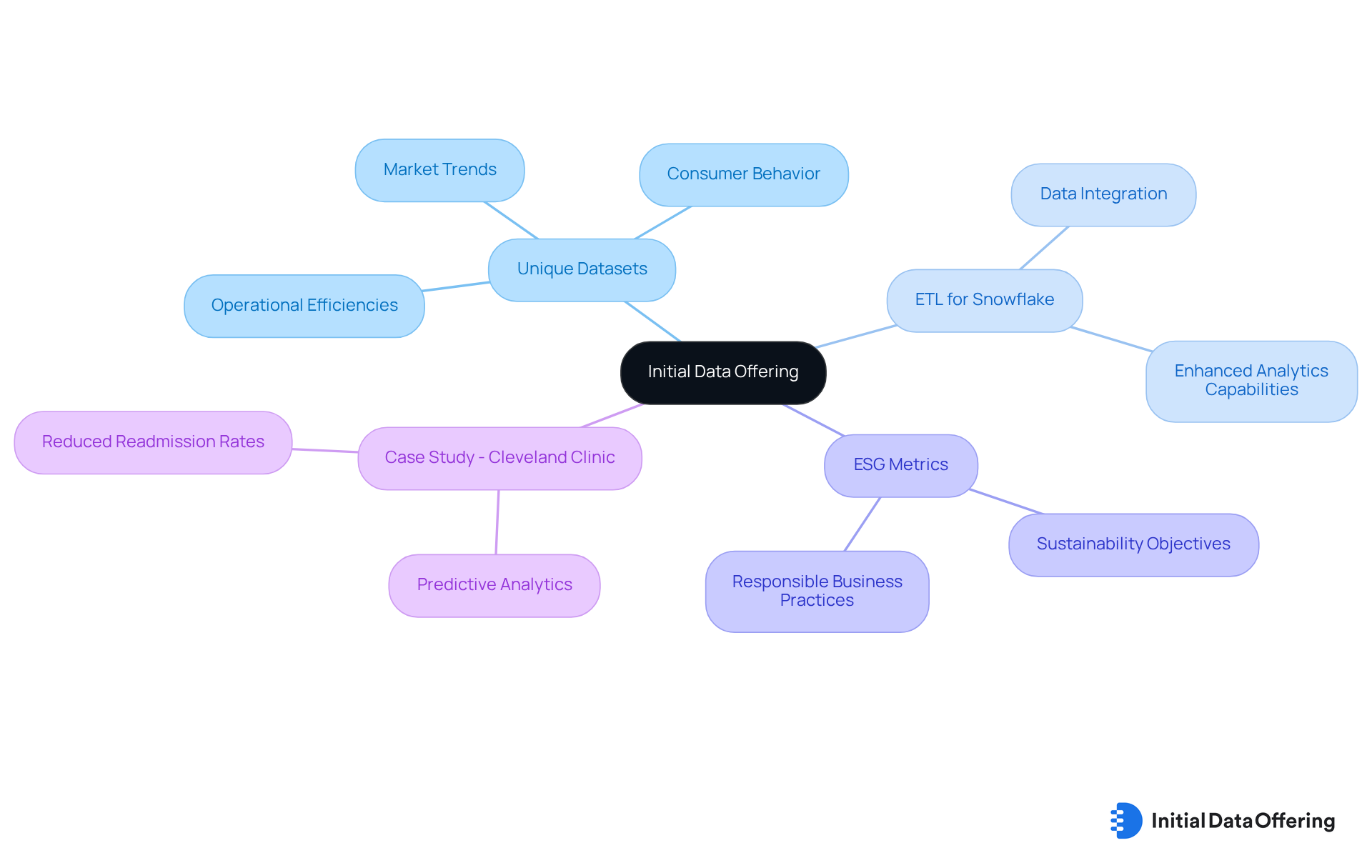
Snowflake-Specific ETL Tools: Tailored Solutions for Effective Data Management
Snowflake provides a suite of ETL for Snowflake solutions that are designed to integrate seamlessly with its architecture. Tools like Matillion, Fivetran, and Stitch provide customized solutions that streamline the ETL for Snowflake process, allowing companies to manage their workflows effectively. These tools support multiple information sources and endpoints, allowing organizations to build robust information pipelines that enhance their analytical capabilities.
For instance, Matillion features a user-friendly interface that empowers users to construct complex ETL for Snowflake workflows without requiring extensive coding knowledge. This accessibility ensures that teams with varying levels of technical expertise can leverage Snowflake's full capabilities while maintaining data integrity and quality.
How might your organization benefit from such tailored ETL solutions? By adopting these technologies, companies can optimize their data handling processes and drive more informed decision-making.
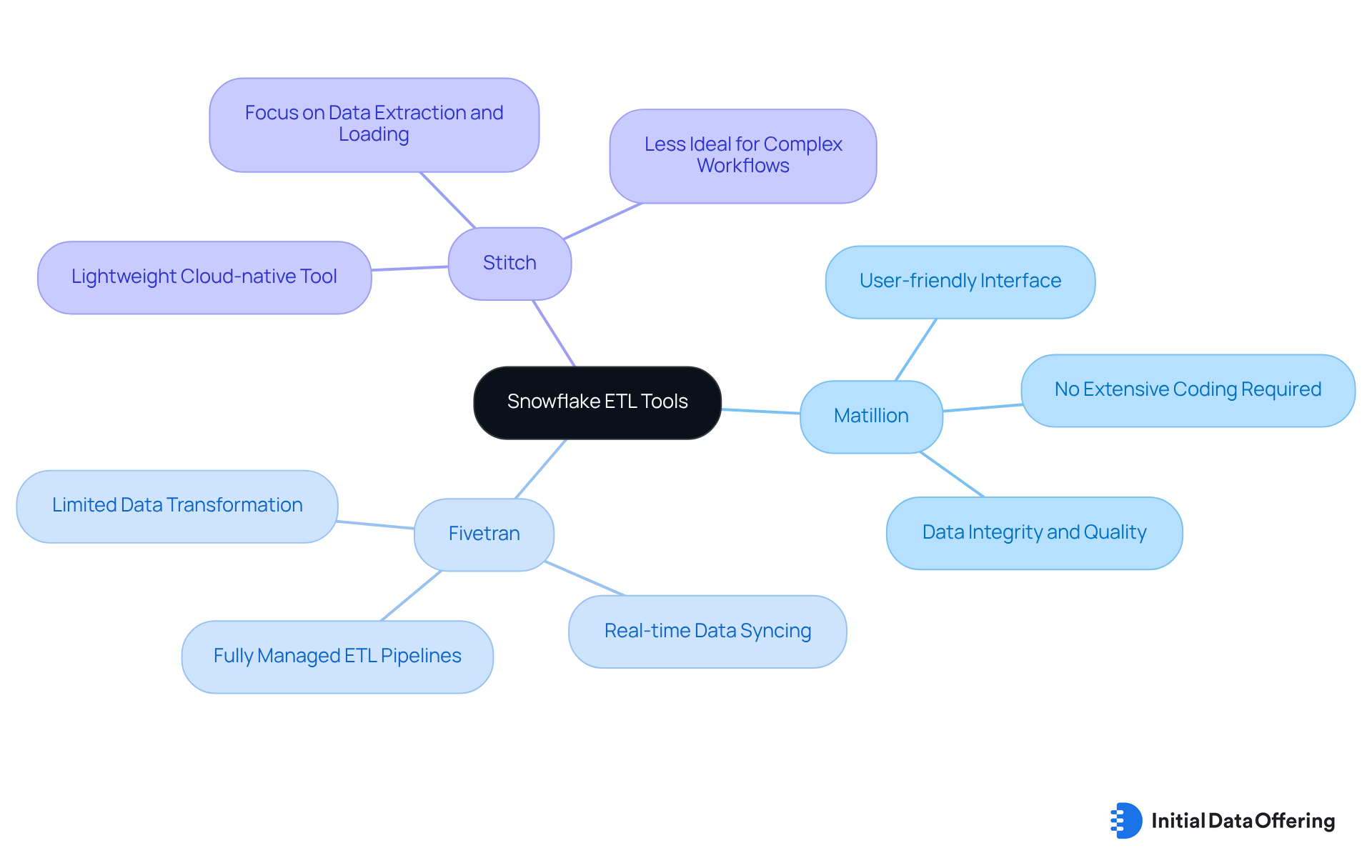
Integration Capabilities: Streamline Data Operations with ETL Tools for Snowflake
ETL for Snowflake applications provide robust integration features that enable organizations to seamlessly connect various information sources. This capability is essential for businesses that depend on diverse datasets for their analytics. For instance, platforms like Apache Airflow and Talend empower users to automate workflows, ensuring that information from multiple sources is consistently refreshed and readily accessible for analysis. Additionally, technologies such as Apache Kafka and Spark Streaming are pivotal in real-time information ingestion and processing, significantly enhancing the functionalities of ETL tools in an information-driven environment.
By optimizing information processes, organizations can reduce the time spent on manual handling and focus on extracting valuable insights from their data. This integration not only boosts operational efficiency but also enhances the accuracy of the information being analyzed, resulting in more reliable business decisions. However, challenges related to information synchronization and latency must be addressed through targeted optimizations to ensure a seamless information flow. As a leader in marketing analytics noted, "Our strategy merged the use of Apache Kafka and Spark Streaming for real-time information processing, alongside Apache Airflow for effective management of batch tasks, allowing our client to extract actionable insights from large and intricate datasets."
Current trends indicate a growing emphasis on real-time information processing and integration, with companies increasingly adopting ETL for Snowflake solutions to maintain competitiveness in an information-driven landscape. Moreover, Snowflake's scalable framework enables organizations to efficiently manage large volumes of data, positioning it as an optimal choice for companies looking to enhance their analytics capabilities.
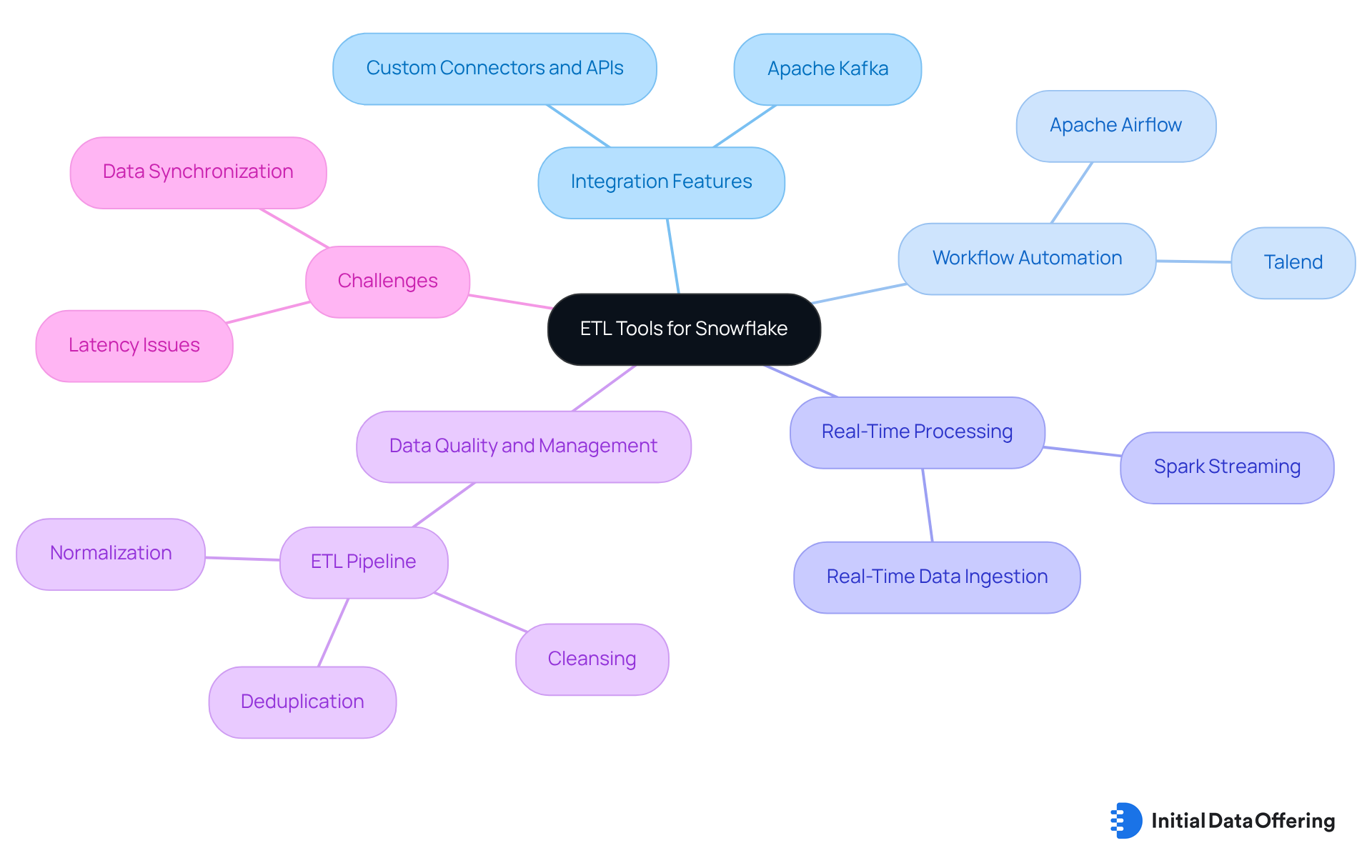
Scalability of ETL Solutions: Future-Proof Your Data Strategy with Snowflake
Scalability stands out as a significant advantage of using ETL for Snowflake solutions. As companies grow and their information requirements evolve, they need ETL tools capable of scaling effectively. Tools like Hevo Data and StreamSets are specifically designed to handle large volumes of data, ensuring that performance remains consistent even as workloads increase.
For instance, Snowflake's architecture facilitates instantaneous scaling, allowing businesses to modify their resources in response to current demands. This flexibility is vital for organizations anticipating rapid growth or shifting information needs, as it empowers them to future-proof their strategies.
How can your organization leverage these scalable solutions? By adopting ETL tools that adapt to changing requirements, businesses can ensure that they are well-equipped to meet future challenges and capitalize on new opportunities.
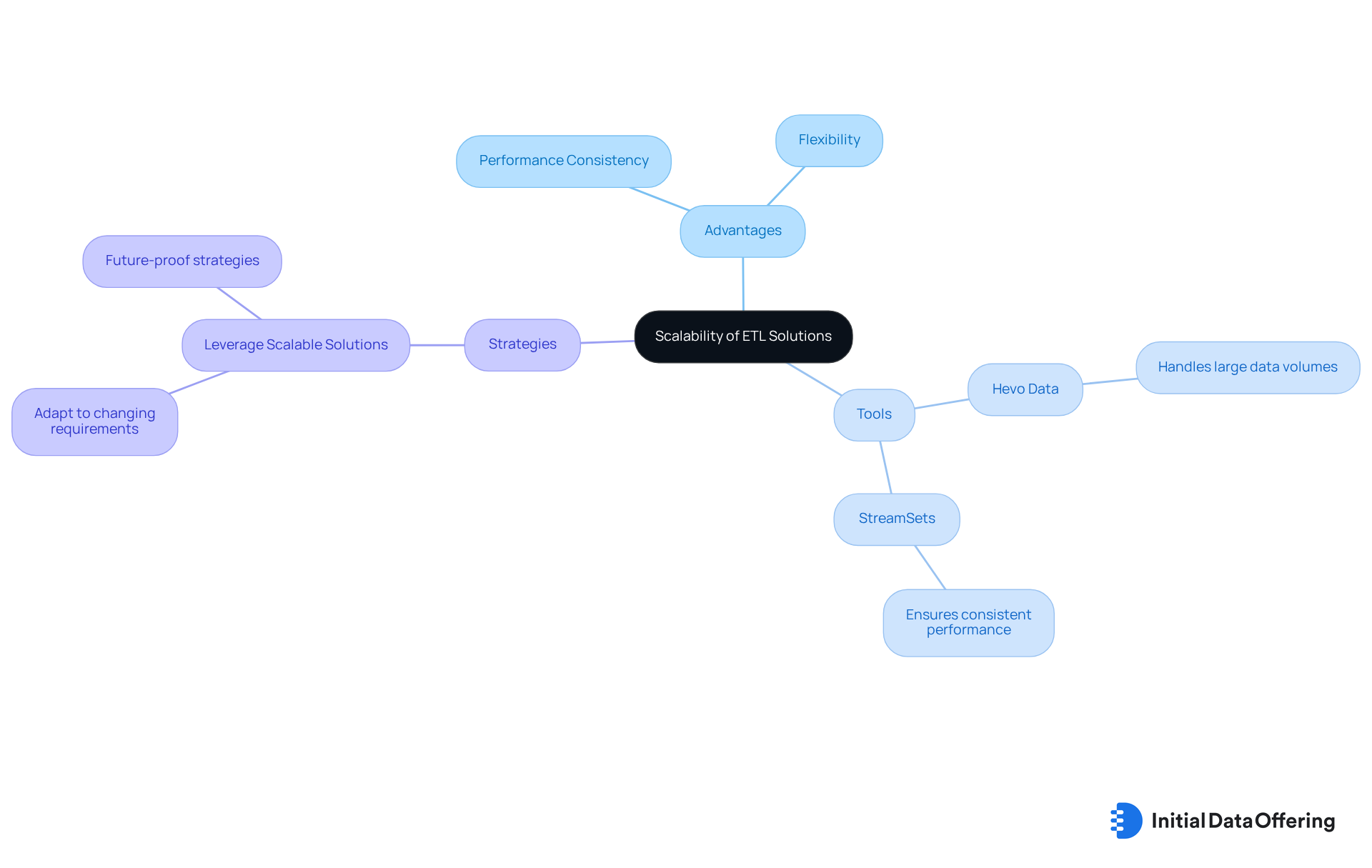
Data Quality Assurance: Elevate Your Analysis with ETL for Snowflake
Information quality assurance is a fundamental aspect of the ETL for Snowflake process, as it directly influences the reliability of insights derived from the information. ETL applications incorporate several validation checks and transformation guidelines to guarantee that the information being loaded is precise and trustworthy. For instance, tools such as Informatica and Talend offer integrated quality features that assist organizations in upholding high standards for their datasets.
Experts emphasize that sustaining information quality is not merely a technical requirement but a strategic necessity. Michael Stonebraker asserts, "Without clean information, or sufficiently clean information, your analytics is worthless," highlighting the critical nature of quality. In sectors such as finance and healthcare, where information accuracy can profoundly affect outcomes, the implications of poor quality can be detrimental. Organizations that prioritize information quality assurance are better positioned to utilize their resources as a strategic asset, leading to improved decision-making and enhanced business performance. Furthermore, companies risk losing $5.2 million in revenue due to unutilized information, underscoring the importance of effective information management.
By effectively utilizing ETL for Snowflake tools, businesses can ensure that their information remains a reliable foundation for analysis, ultimately driving better results across various applications. This approach not only enhances information quality but also addresses potential cultural obstacles to becoming an analytics-focused organization, fostering an environment where evidence-based decision-making can thrive.

Cost-Effectiveness: Optimize Your Data Strategy Budget with ETL for Snowflake
Cost-effectiveness is a crucial factor for organizations that are adopting ETL for Snowflake solutions. Numerous ETL tools, such as Fivetran and Stitch, offer pricing structures that are usage-based. This model enables companies to pay solely for the information they truly utilize.
For example, Fivetran's pricing is structured around the number of monthly active rows, allowing for up to 500,000 rows under its Starter plan. In contrast, Stitch presents a tiered model that begins at $100 monthly for up to 300 million rows, with a Premium plan starting from $1,250 per month for 100 million rows. This flexibility caters to varying volumes and integration needs. Additionally, Hevo's pricing starts at $239 monthly for up to 1 million events, providing further options for companies to contemplate.
By enhancing their ETL for Snowflake processes, organizations can significantly reduce unnecessary expenses while ensuring access to vital information for analysis. This strategic approach not only promotes efficient resource allocation but also improves the overall effectiveness of their information strategy. As information teams face escalating expenses in the contemporary information stack, leveraging these adaptable pricing models becomes increasingly essential for maintaining budgetary oversight and enhancing information operations.
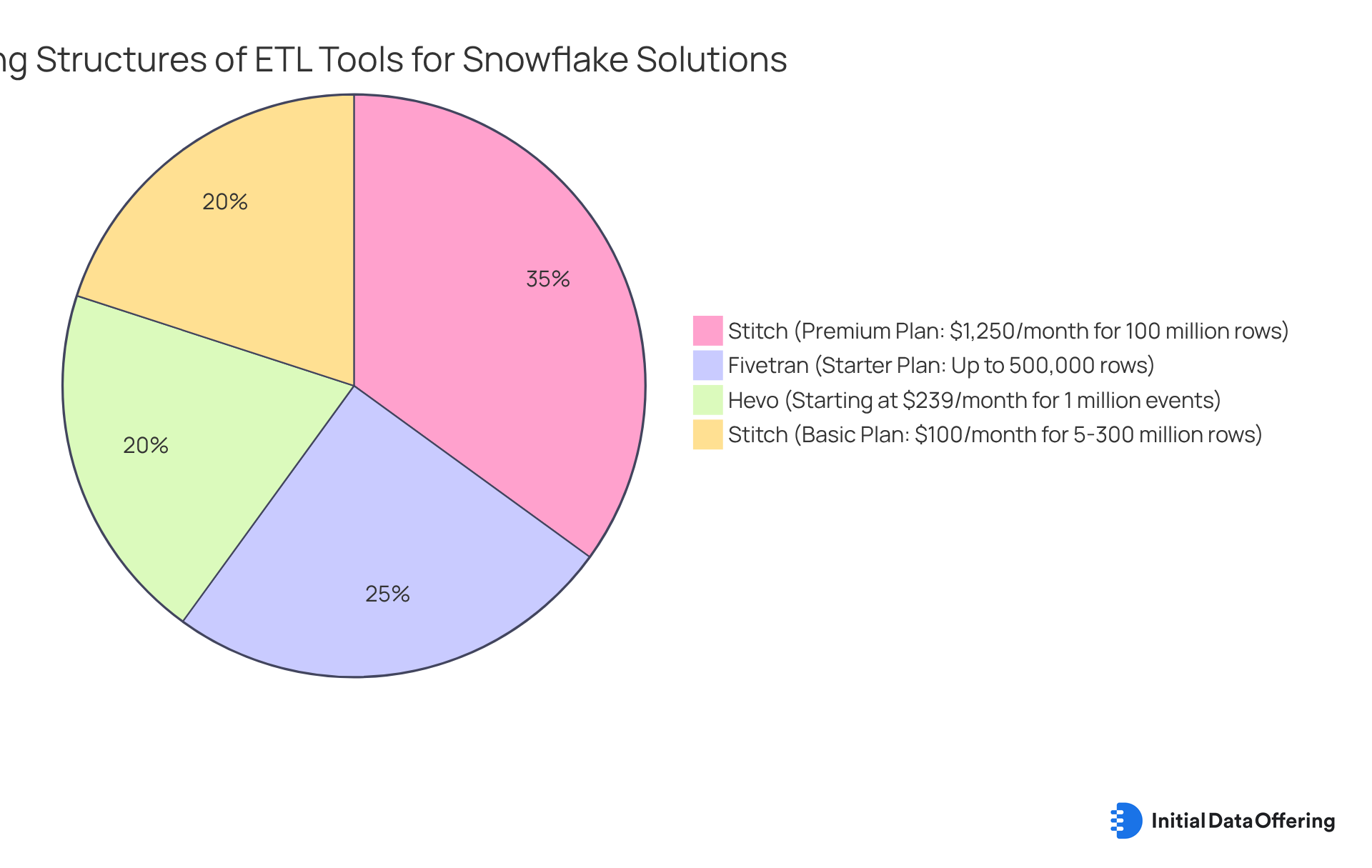
User-Friendly ETL Tools: Simplify Your Data Strategy Implementation for Snowflake
User-friendly ETL for Snowflake solutions are crucial for companies that aim to optimize their information strategy execution. Solutions such as Matillion and Talend boast intuitive interfaces that empower users to design and manage ETL workflows without the need for extensive coding expertise. This feature not only simplifies the process but also enhances productivity, as indicated by industry specialists who note that intuitive interfaces enable teams to engage with information processes more efficiently. As a result, a collaborative atmosphere emerges, facilitating the exchange of information across departments.
By adopting these accessible ETL resources, companies can significantly boost productivity and ensure efficient information utilization throughout the enterprise. This democratization of information access is vital for fostering innovation and enabling informed decision-making. Current trends in user-friendly information management solutions underscore the importance of accessibility and simplicity, which are essential for organizations seeking to adapt to evolving information requirements in 2025. Moreover, addressing common challenges in ETL for Snowflake integration, such as load failures and format incompatibilities, can further enhance the effectiveness of these resources in achieving seamless workflows.
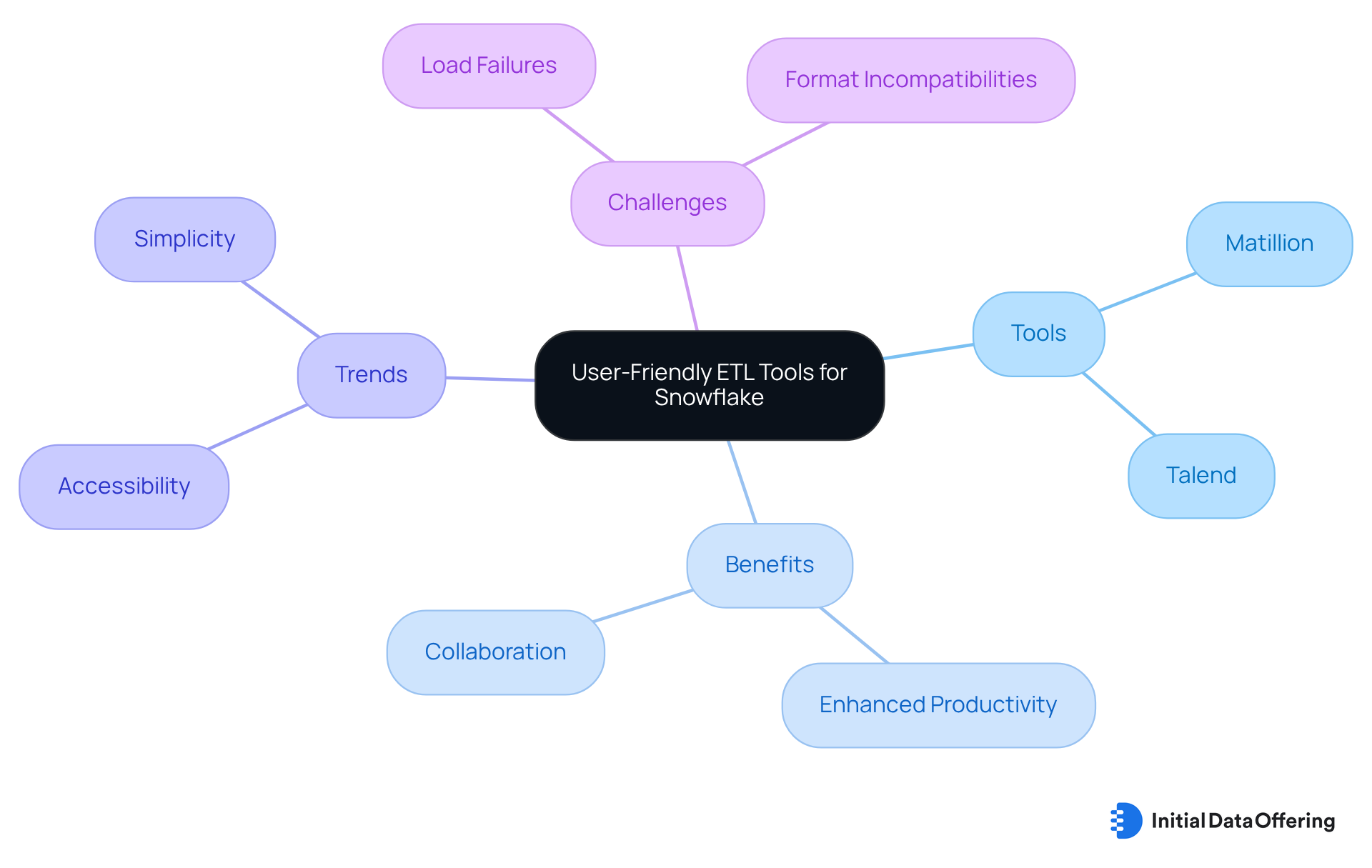
Real-Time Data Processing: Gain Timely Insights with ETL for Snowflake
Live information processing is revolutionizing how entities leverage ETL for Snowflake, enhancing their data handling capabilities. Solutions such as StreamSets and Apache Kafka empower businesses to capture and process information instantaneously, yielding timely insights that are crucial for informed decision-making. This capability is especially vital in sectors like finance and e-commerce, where the ability to respond swiftly to market fluctuations can significantly influence success.
By adopting real-time information processing, organizations enhance their agility and responsiveness. This enables them to seize emerging opportunities and effectively mitigate risks. For instance, companies utilizing real-time analytics have reported a 23% increase in profitability, underscoring the financial advantages of timely insights. Furthermore, businesses that implement sophisticated analytics are 19 times more likely to achieve profitability, highlighting the essential role of real-time information in guiding strategic decisions within finance and e-commerce.
In the finance sector, real-time insights allow firms to adjust their strategies based on market trends. In e-commerce, these insights facilitate personalized customer experiences that can elevate retention rates by 20%. Companies like Netflix and Amazon exemplify this by utilizing real-time information to tailor their offerings, thereby enhancing customer satisfaction and loyalty. As organizations prepare for 2025, the integration of real-time information analytics will become increasingly critical, with projections indicating that nearly 95% of firms will invest in this technology to refine their decision-making processes.
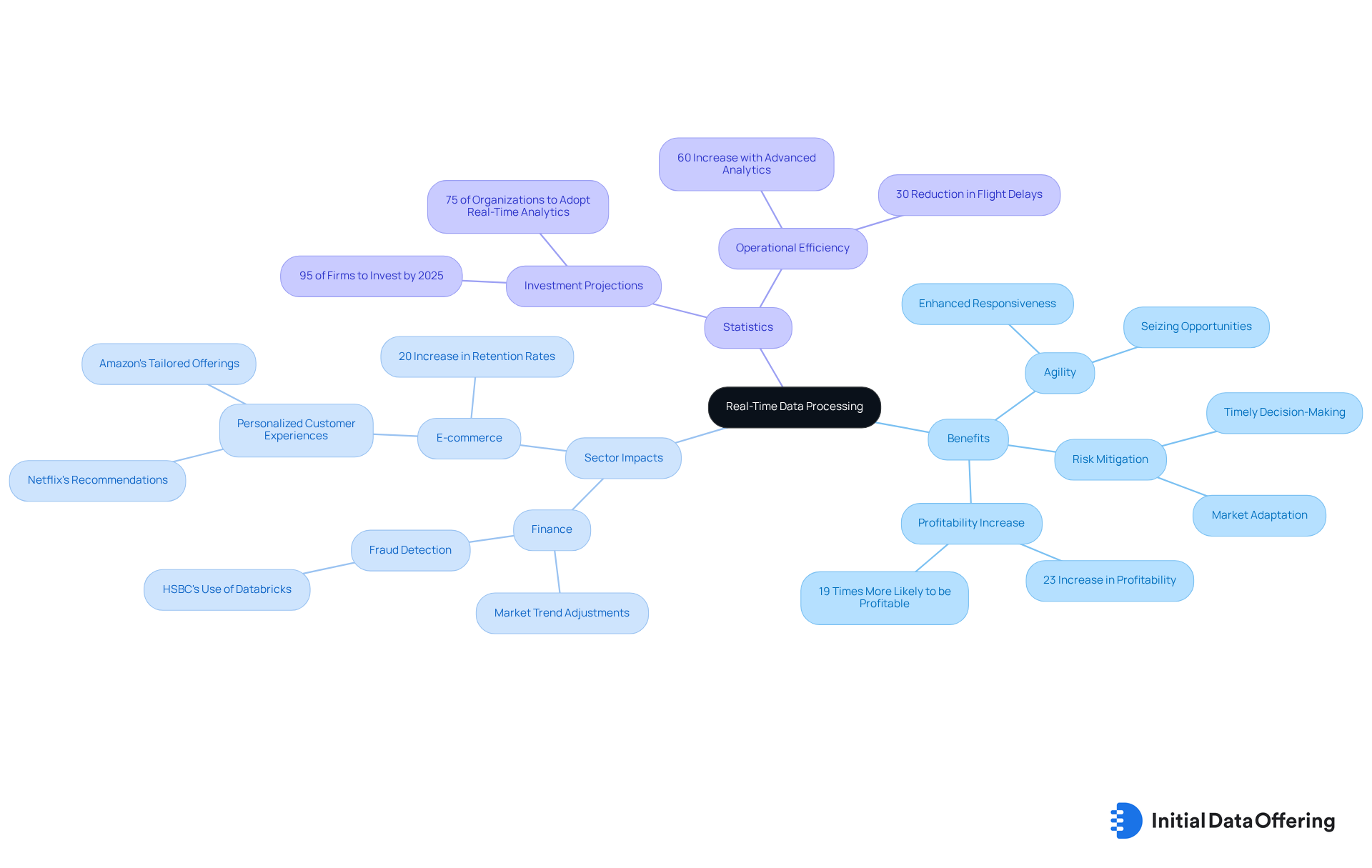
Challenges of ETL Implementation: Navigate Common Obstacles with Snowflake
Executing ETL for Snowflake presents notable challenges, particularly concerning quality issues, schema mismatches, and performance bottlenecks. A crucial aspect of effective ETL execution is ensuring that data types correspond across various sources, which helps prevent errors during the transformation process. For example, organizations like Nationwide have automated their information quality procedures, transforming challenges into competitive advantages by leveraging resources that enhance reliability and efficiency.
Information engineers often cite insufficient tools for automating quality processes as a significant barrier to achieving high-quality data, with 49% of respondents highlighting this issue. Furthermore, information quality problems cost the average company $12.9 million annually, underscoring the financial ramifications of these challenges. To navigate these obstacles effectively, companies should invest in training and resources that empower their teams with the necessary skills to proficiently manage ETL for Snowflake workflows. Additionally, establishing key performance indicators (KPIs) for information quality can aid organizations in continuously monitoring and improving their ETL processes.
As one engineer remarked, 'Investing in the right tools and training is essential for addressing quality challenges in ETL processes.' By proactively addressing these common challenges, businesses can optimize their ETL for Snowflake implementation, enhance information integrity, and fully leverage Snowflake as a strategic platform. This approach not only mitigates risks associated with poor information quality but also fosters a culture of continuous improvement, ultimately leading to more effective, information-driven decision-making.

Strategic Advantages: Why ETL for Snowflake is Essential for Your Data Strategy
Incorporating ETL for Snowflake provides significant strategic benefits for companies aiming to enhance their information management capabilities. These tools provide features such as:
- Improved information quality
- Real-time processing
- Cost-effectiveness
- Scalability
As a result, businesses can leverage their insights more effectively, leading to better decision-making and operational efficiency.
By adopting a robust ETL for Snowflake strategy, organizations are positioned to navigate the complexities of modern data environments. This proactive approach not only equips them to make informed decisions but also drives innovation and helps maintain a competitive edge in their respective markets. Are you ready to explore how these tools can transform your data management processes and elevate your business outcomes?
Conclusion
Incorporating ETL for Snowflake into a data strategy transcends a mere technical upgrade; it signifies a fundamental shift in how organizations can leverage data for strategic advantage. By utilizing ETL processes, businesses can integrate unique datasets, streamline operations, and enhance their analytical capabilities. This ultimately leads to more informed decision-making and fosters innovation.
The article outlines several critical benefits of ETL for Snowflake. These include:
- Improved data quality
- Real-time processing
- Scalability
- Cost-effectiveness
Each of these features plays a vital role in enabling organizations to adapt to evolving data needs while optimizing their resources. Furthermore, the importance of user-friendly tools and robust integration capabilities is paramount, as they empower teams across various skill levels to engage with data effectively.
As businesses look to the future, embracing ETL for Snowflake is essential for maintaining a competitive edge in an increasingly data-driven landscape. By investing in these strategies, organizations can enhance their information management and unlock new opportunities for growth and efficiency. The call to action is clear: prioritize ETL solutions to transform data into a strategic asset that drives success in 2025 and beyond.
Frequently Asked Questions
What is an Initial Data Offering (IDO) and how can it benefit businesses?
An Initial Data Offering (IDO) provides businesses with unique datasets tailored to their specific needs, enhancing their data strategy. By utilizing ETL for Snowflake to integrate these datasets, companies can gain insights into market trends, consumer behavior, and operational efficiencies, leading to informed decision-making and a competitive advantage.
How can ESG metrics impact business strategies?
Datasets focused on ESG (Environmental, Social, and Governance) metrics help companies align their strategies with sustainability objectives, promoting responsible business practices. For example, Cleveland Clinic reduced readmission rates by 21% through predictive analytics that identified high-risk patients, illustrating the benefits of integrating ESG considerations into healthcare strategies.
What are the advantages of using alternative datasets?
Alternative datasets can reveal market movements that traditional datasets may miss, allowing businesses to adapt quickly to changing conditions. Companies that leverage curated datasets through ETL for Snowflake have reported improvements in their analytical capabilities, enabling better decision-making that drives innovation and strategic planning.
What ETL tools are available for Snowflake?
Snowflake offers a range of ETL tools such as Matillion, Fivetran, and Stitch, which are designed to integrate seamlessly with its architecture. These tools help streamline the ETL process and support multiple information sources, allowing organizations to build robust information pipelines.
How does Matillion facilitate ETL for Snowflake?
Matillion features a user-friendly interface that allows users to create complex ETL workflows without extensive coding knowledge. This accessibility enables teams with varying technical expertise to utilize Snowflake effectively while ensuring data integrity and quality.
What integration capabilities do ETL tools for Snowflake provide?
ETL tools for Snowflake offer robust integration features that connect various information sources, essential for businesses relying on diverse datasets. Tools like Apache Airflow and Talend automate workflows, ensuring consistent data refresh for analysis, while Apache Kafka and Spark Streaming enhance real-time information ingestion and processing.
How do ETL tools improve operational efficiency?
By optimizing information processes, ETL tools reduce the time spent on manual data handling, allowing organizations to focus on extracting valuable insights. This optimization boosts operational efficiency and enhances the accuracy of analyzed information, leading to more reliable business decisions.
What challenges do organizations face with information synchronization and latency?
Organizations must address challenges related to information synchronization and latency to ensure a seamless flow of information. Targeted optimizations are necessary to maintain effective data integration and processing.
Why is real-time information processing becoming increasingly important?
Current trends show a growing emphasis on real-time information processing and integration, as companies adopt ETL for Snowflake solutions to remain competitive in an information-driven landscape. Snowflake's scalable framework allows efficient management of large data volumes, enhancing analytics capabilities.